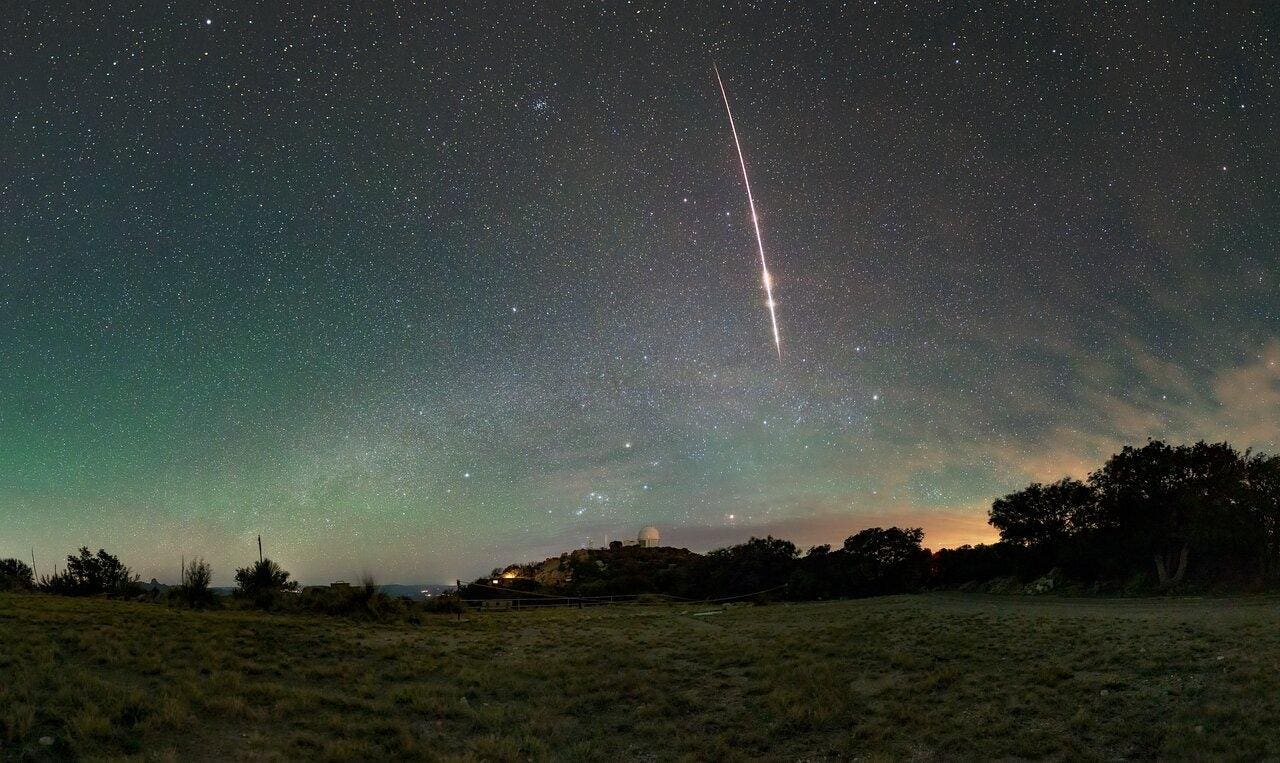A fireball streaks across the morning sky above NSF Kitt Peak National Observatory (KPNO), a Program of NSF NOIRLab funded by the U.S. National Science Foundation. T
KPNO/NOIRLab/NSF/AURA/J. Dai
August is one of the best months of the year for stargazing, and 2025 is no exception. Whether you’re scanning the eastern sky at dusk or venturing out before sunrise, there’s something to see almost every night. The Perseids return, the Milky Way arches high overhead, and a rare “planet parade” delivers four bright objects in the morning twilight. Here’s everything you need to know about the night sky in August 2025:
1. A Full ‘Sturgeon Moon’
When: dusk on Friday and Saturday, August 8-9
Where: eastern horizon
This month’s full moon will occur early on Aug. 9, but both Aug. 8 and Aug. 9 will offer dramatic moonrises. Look east shortly after sunset to watch the sturgeon moon rise, appearing a lovely orange color.
The Art Deco spire of the Kansas City Power and Light building stands against the full moon as it rises beyond the downtown skyline Saturday, Aug. 21, 2021, in Kansas City, Mo. The August full moon is known as the sturgeon moon. (AP Photo/Charlie Riedel)
ASSOCIATED PRESS
2. A Conjunction Of Venus And Jupiter
When: before dawn on Tuesday, Aug. 12
Where: east-northeast horizon
In a rare planetary pairing, Venus and Jupiter will be separated by just one degree in the pre-dawn sky. This is a striking sight for the naked eye, with the two brightest planets close together, just above the eastern horizon an hour before sunrise.
3. Perseid Meteor Shower Peaks
When: around midnight, August 12-15
Where: northeast to overhead
The Perseids reach their maximum overnight on Aug. 12-13 evening, but a 91%-lit gibbous moon will wash out all but the brightest. For the best chance, head out before midnight and keep your back to the moon. Better still, wait until Aug. 15, when the night sky will be much darker, and there will still be an elevated rate of meteors.
A meteor streaks across the night sky above Leeberg hill during the Perseid meteor shower on August 13, 2023 in Grossmugl, Austria. (Photo by Heinz-Peter Bader/Getty Images)
Getty Images
4. A Planet Parade
When: one hour before sunrise, Sunday to Wednesday, August 17–20
Where: eastern sky
For four consecutive mornings, Jupiter, Venus and Mercury form a graceful arc in the pre-dawn sky. The waning crescent moon moves past them each morning, getting slimmer each day. The highlight comes Aug. 20 when a 9% crescent moon sits next to Venus.
5. Milky Way At Its Best
When: after astronomical twilight, all month
Where: southeast to the zenith
August’s moonless evening sky — from Aug. 16-26 — brings some of the clearest views of the Milky Way for northern observers. On moonless nights, trace its arc through the Summer Triangle stars high in the southeast and down to the galactic core near the constellations Scorpius and Sagittarius in the south. Do whatever you can to escape light pollution, using a light pollution map or staying overnight in an International Dark Sky Place.
The Milky Way over the Garden of Eden in Arches National Park near Moab, Utah. (Photo by: Jon G. Fuller/VWPics/Universal Images Group via Getty Images)
VW Pics/Universal Images Group via Getty Images
6. A ‘Black Moon’
When: Saturday, Aug. 23
Where: all-sky
Today’s new moon has a special name — a seasonal “black moon,” the third new moon in a season of four. Although not visible itself, its presence means an entire night of dark, moonless night skies ideal for stargazing, astronomy and astrophotography.
7. Venus And The Beehive Cluster
When: before dawn on Sunday, Aug. 31
Where: east-northeast sky
Look east an hour before sunrise to find brilliant Venus. Nearby, through binoculars, you’ll spot the faint but pretty Beehive Cluster (M44). This open cluster in the constellation Cancer is one of the most beautiful sights in the night sky — especially when paired with a bright planet.
Wishing you clear skies and wide eyes.









